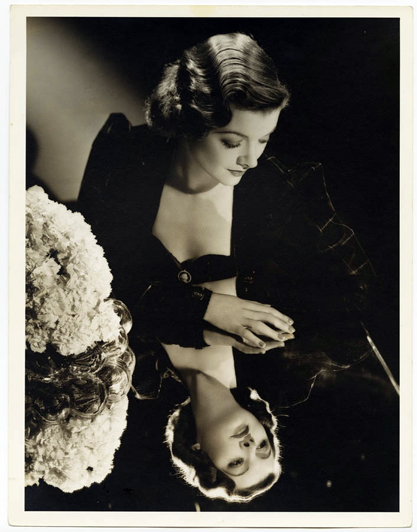 |
| Above: Full view |
A rare and exceedingly beautiful gelatin silver, double weight gallery photograph of film star Myrna Loy by Laszlo Willinger. This image utilizes a mirrored table to capture the beautiful Loy in a double image. The mirror image was one of the most innovative trends in art deco photography, as it relied on the precision lighting and bold crisp costuming that typified the period. Willinger, who worked with Metro-Goldwyn-Mayer’s top stars from 1937-1944, was a master at bringing out the sophisticated beauty of women like Myrna Loy, as seen in this rare print. Large double-weight photographs such as this were never intended for widespread distributions, and were hand printed by the photographers themselves. This is a particularly captivating piece of fine art glamour photography, and captures a marquis film star by a top artist. We are pleased to be able to offer this wonderful photograph and many other large format vintage gallery portraits from the Golden age of Hollywood for sale exclusively through Grapefruit Moon Gallery.
 |
| Above: Detail |
 |
| Above: Detail |
 |
| Above: Verso view |
A biography of Laszlo Willinger:
Laszlo Willinger was born in Budapest, Hungary. He was a photographer most noted for his portrait photography of movie stars and celebrities during the 1930s and 1940s.
Taught by his mother who was also a photographer, Willinger established photographic studios in Paris and Berlin in 1929 and 1931 respectively, and at the same time submitted his photographs to various newspapers as a freelance contributor. He left Berlin in 1933 when Adolf Hitler became Chancellor, settling and working in Vienna where he began to photograph such celebrities as Marlene Dietrich, Hedy Lamarr, Sigmund Freud, Carl Jung, and Max Reinhardt.
By the mid 1930s he was traveling through Africa and Asia before being invited by studio photographer Eugene Robert Richee to move to the United States. After establishing a studio in Hollywood, California, Willinger became a frequent contributor to magazines and periodicals, providing magazine cover portraits of some of the most popular stars. Willinger was one of the first Hollywood photographers to experiment in the use of color.
In later years, shortly before his death, Willinger had been accused of stalking some celebrities of the time, including Charlie Chaplin. An investigation into the matter led to the uncovering of thousands of personal pictures of the male comedy star. He committed suicide shortly after the accusations.
Willinger’s portraits have become collectible and are appreciated as fine art. His 1940 series of portraits of actors Laurence Olivier and Vivien Leigh are housed in London’s National Portrait Gallery.
A biography of Myrna Loy:
During the late 1930s, when Clark Gable was named the King of Hollywood, Myrna Loy was elected the Queen. The legendary actress, who started her career as a dancer, moved into silent films and was typecast for a few years as exotic women. Her film titles from those early years include Arrowsmith (1931), Love Me Tonight (1932), The Mask of Fu Manchu (1932), and Manhattan Melodrama (1934), the film that gangster John Dillinger just had to see the night he was killed. Starting in 1934, with The Thin Man, opposite William Powell, she became Hollywood’s ideal wife: bright, witty, humorous. She and Powell were often teamed throughout the ’30s and ’40s, and many of the characters she played were strong, independent, adventurous women. In addition to The Thin Man series, Loy’s best appearances included The Great Ziegfeld (1936), Libeled Lady (1936), Wife vs. Secretary (1936), Test Pilot (1938), and Too Hot to Handle (1938). She took a break from filmmaking during WWII to work with the Red Cross, and in her later years she devoted as much time to politics as to acting (among her accomplishments, Loy became the first film star to work with the United Nations). She stands out in The Best Years of Our Lives (1946), Mr. Blandings Builds His Dream House (1948), Cheaper by the Dozen (1950), and its sequel Belles on Their Toes (1952). She received an honorary Oscar in 1991, two years before her death.
